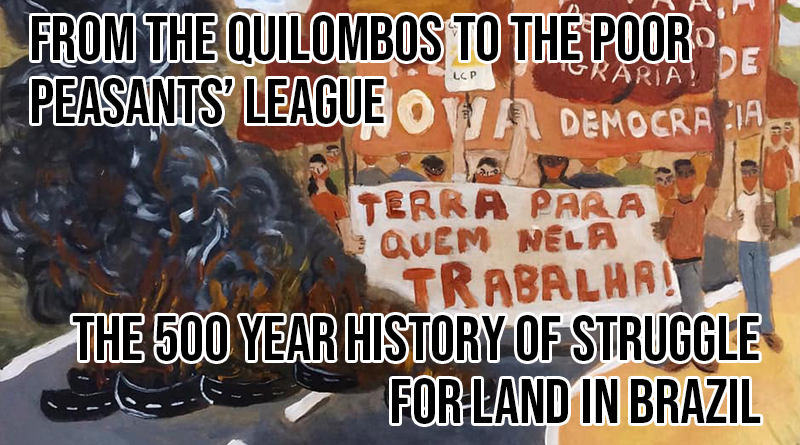From the Quilombos to the Poor Peasants’ League—the 500 year history of struggle for land in Brazil
Since Brazil is the site of the first slave uprising in Latin America with the quilombo rebellion that began in the 16th century and has had a history of uninterrupted struggle since then against colonialism and today, imperialism, it would be logical that the history of the revolutionary movement would be well-covered by books, articles and studies.
But while the old struggles have been analyzed and even co-opted by the government of the opportunist phony left that governed Brazil for almost fourteen years (from 2003 until 2016), it is hard to find information on the struggles of the revolutionary forces today.
This article is the first of a series of articles that aims at giving more insight into the revolutionary movement that has, since 1995, struggled against imperialist aggression, successive shift of governments, a government that portrays itself as “leftist” and “pro-people” but actually continued acting on behalf of its imperialist lords, including massacring peasants, and the current government of the fascist Bolsonaro.
1. From Colonization to 1995
To have a better understanding of the struggle for land in Brazil, it is necessary to first see it in the context of Portugal’s colonization in 1500, which lasted officially until 1822 when a formal policy of a mere separation from the kingdom of Portugal as the “Empire of Brazil” and under the semi-colonial yoke of England took place. In reality, the ownership of the land remained the same as during colonial times: concentrated in the hands of a small minority. Less than 2% of the population that owns lands (called the latifundio) possess 50% of the land, while 91% of landowners, who are peasants, possess less than 20% of the land. 5 million peasant families do not have any land, despite several “land reforms” that were supposedly carried out or promised by different governments.
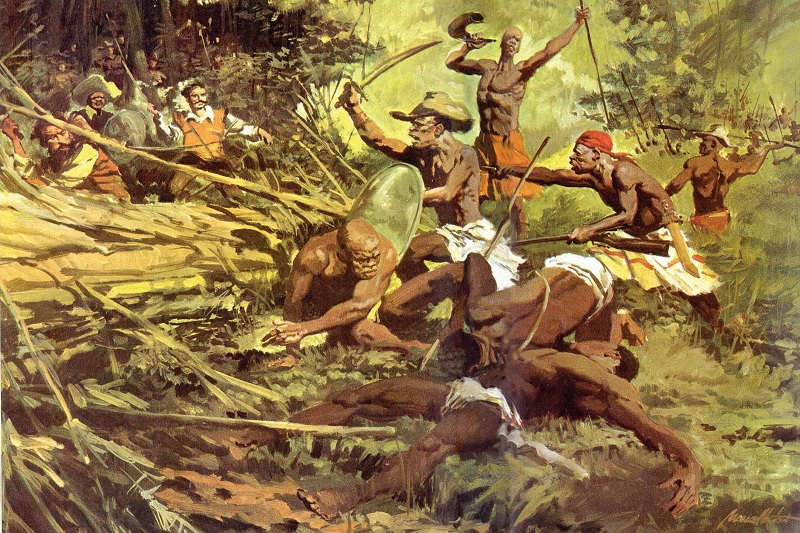
The first rebellion to reclaim the right to land was led by communities of escaped African slaves called the quilombos (meaning “war camp”). There have been many quilombo rebellions since the very beginning of the Portuguese colonization, but their numerical and military weakness compared to the colonizers put them in a defensive position. Quilombo dos Palmares, in the Northeast of the country, the most important of them lasted a hundred years, resisting several campaigns of encirclement and finally succumbed in 1694. Thus the land they were forced to seek was difficult to access and isolated, and it was impossible to seize large tracts of land. This situation made them de facto poor peasants. Furthermore with the end of slavery in 1888, the masses of former slaves, left to their own chances, entered the deep unexplored zones of the country, where they established communities, many of which remain until today and have kept struggling for the ownership of their territories.
At the end of the 19th century and the beginning of the 20th, there was a series of so-called “messianic” revolts, so named because their main leaders were pious preachers who gave a deeply religious character to their movements. This is the case for the Canudos revolt in the northeastern part of the country, led by Antonio Conselheiro, which lasted for around 30 years (1867 to 1897). They faced three military campaigns in what is considered until today the “deadliest civil war” in Brazilian history. In addition, the “War of Contestado” (from 1912 to 1916) in the South was one of the biggest peasant wars in South America. All of the struggles had as their main goal land for the tillers, and all of them were bloodily repressed by the colonial repressive forces and, since independence, by the Brazilian army.
The struggle for land intensified in the 1940s with a series of spontaneous upsurges and land seizures, inspired on the one hand by the armed uprising of November 1935, led the Communist Party of Brazil (PCB), and on the other hand by the end of the Vargas military regime (1930-1945). The PCB led those movements, organizing peasant associations and the Peasant Leagues, mainly between 1948 and 1954. In 1953, after a process of uniting the different unions of rural workers and poor peasants, it achieved its 1st National Conference of the Agricultural Workers and Poor Peasants which created the ULTAB (Union of Peasants and Agricultural Workers of Brazil).
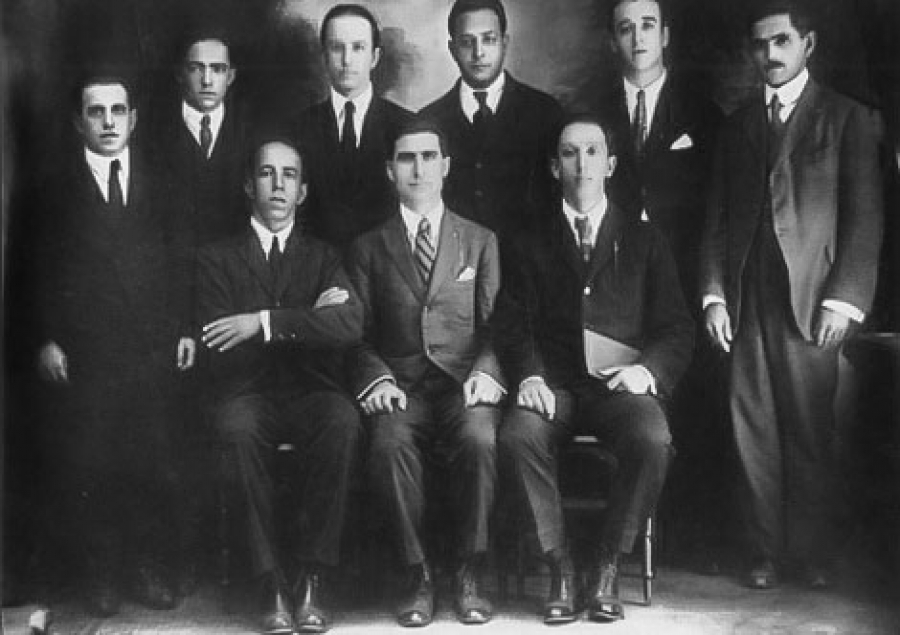
PCB leadership over the peasant movement gave it a more defined political character by providing a clear political line—the necessity of agrarian reform—and showing a clear path to reach this goal: armed struggle, symbolized by the struggle of Porecatu (in the State of Paraná), during which over 300 families occupied 4000 hectares (40 km2) of land. The peasants defended their seized land by organizing armed militias that initially had a defensive role, but as the struggle intensified, initiated tactical offensives against the latifundio and their gunmen.
The example of Porecatu inspired many other armed occupations, such as the ones of the south of Bahia, and the ones from the Triângulo Mineiro of Trombas and Formoso. The peasants organized themselves into militant leagues and their struggle became a reference point for armed movements all over Latin America.
The growth of the movement was halted by two events: 1. The appointment of Joao Goulart, a social-democrat representative of the national bourgeoisie and defender of “base reforms”, as the Labor Minister, and later his election as president of Brazil. He co-opted the majority of the unions and mass organizations and opposed the peasant movement. The movement, with the flag of “agrarian reform by law or by force,” persisted with its armed resistance in spite of the promise of a series of progressive reforms (such as increasing the minimum wage by 100% and vague promises of a “land reform”); and 2. A new shift to the right in the PCB leadership, allowing the reformist line contrary to the armed struggle to prevail. Embracing Khrushchev’s line soon after 1956, the line led the Party to abandon the Peasant Leagues and centered the struggle for land in the legal struggle and demands to successive populist governments for an “agrarian reform”—rejecting the alliance of struggle it made with the peasants through arms as a “left opportunist” deviation.
This led to an internal split of the Party with Khrushchevist revisionism, for the general reorganization of the Party as PCdoB and for the armed struggle as people’s war, adopting Mao Zedong Thought. Thus, the leagues were still led by communists and other forces of the left influenced by the Cuban Revolution. Their continued growth became so problematic for the imperialist interests controlling Brazil that it fomented a military coup in 1964. The newly installed fascist military regime’s first act was to ban all of the peasant leagues and repress them, leading to a bloody massacre of their leaders and masses.
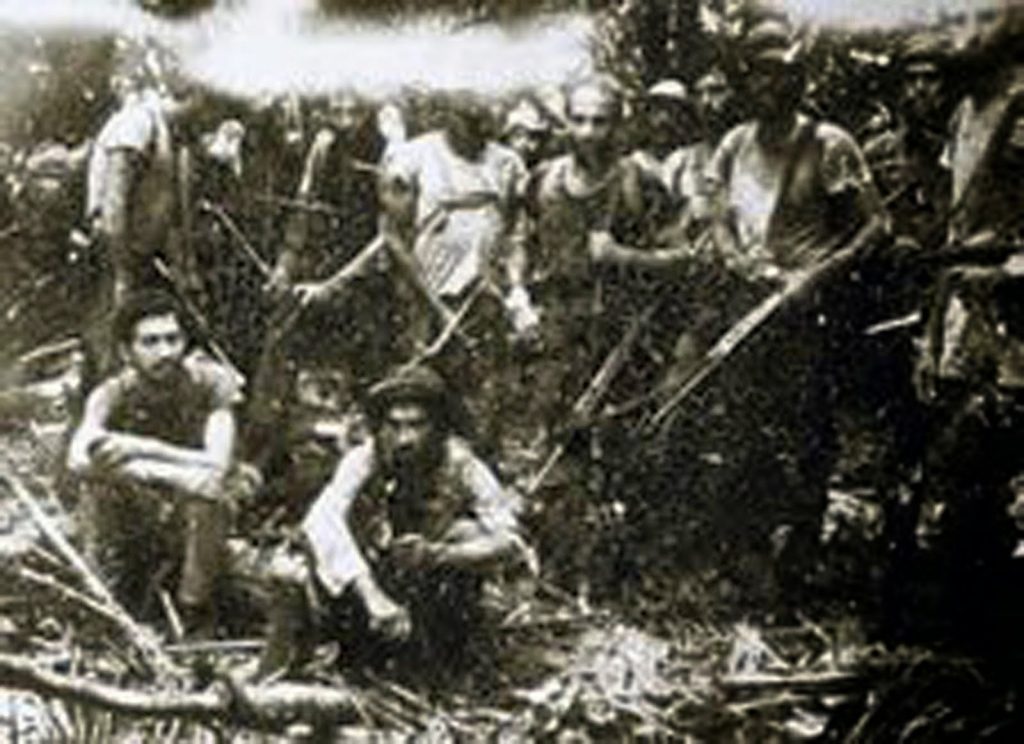 The military regime was effective in its repression; the Araguaia Guerrilla, in Pará, Eastern Amazônia, (a region of vast tropical amazon forest that covers more than 60% of the 8,5 million km² of the Brazilian territory, although a great part of the forest has been devastated), where the reorganized communist party struggled together with the peasants to carry out the People’s War was defeated after three years of resistance. The struggle for land became disorganized and only when the regime started to weaken (at the end of 70s) did new organizations appear again, some led by more liberal priests of the Catholic Church. In 1985 the Landless Workers’ Movement (MST) was founded and in 1995, the Worker’s and Peasant’s League is founded but quickly separated into the Worker’s League and the Poor Peasant’s League.
The military regime was effective in its repression; the Araguaia Guerrilla, in Pará, Eastern Amazônia, (a region of vast tropical amazon forest that covers more than 60% of the 8,5 million km² of the Brazilian territory, although a great part of the forest has been devastated), where the reorganized communist party struggled together with the peasants to carry out the People’s War was defeated after three years of resistance. The struggle for land became disorganized and only when the regime started to weaken (at the end of 70s) did new organizations appear again, some led by more liberal priests of the Catholic Church. In 1985 the Landless Workers’ Movement (MST) was founded and in 1995, the Worker’s and Peasant’s League is founded but quickly separated into the Worker’s League and the Poor Peasant’s League.
2. The Resistance of Corumbiara, and the Battle of Santa Elina
When the necessity of the military regime waned and its rule was completely ended in 1985, the bourgeoisie presented it as a “return of the democracy” that would give back total “freedom of speech” and “freedom of association.” This situation allowed peasants to form the “Landless Workers’ Movement” (MST), which aimed to continue the struggle of the peasants leagues for agrarian reform.
In the meantime, the Workers’ Party (PT), a social-democratic party founded in 1982, portrayed itself as a defender of worker and peasant rights, a role they had undertaken since the early 80s. With the end of the social-imperialist USSR and the “fall of the Berlin Wall,” the opportunists let their false masks of Marxism fall and centered their struggle in the corrupt elections of the country. The majority of the leadership of the MST hoped for the PT’s success in the elections and believed that the possibility of agrarian reform would follow.
While this contradiction was discussed and debated in the first decade of the MST, the situation in Rondonia showed the contradiction’s irreconcilable character and drew a line of demarcation between opportunists and revolutionaries.
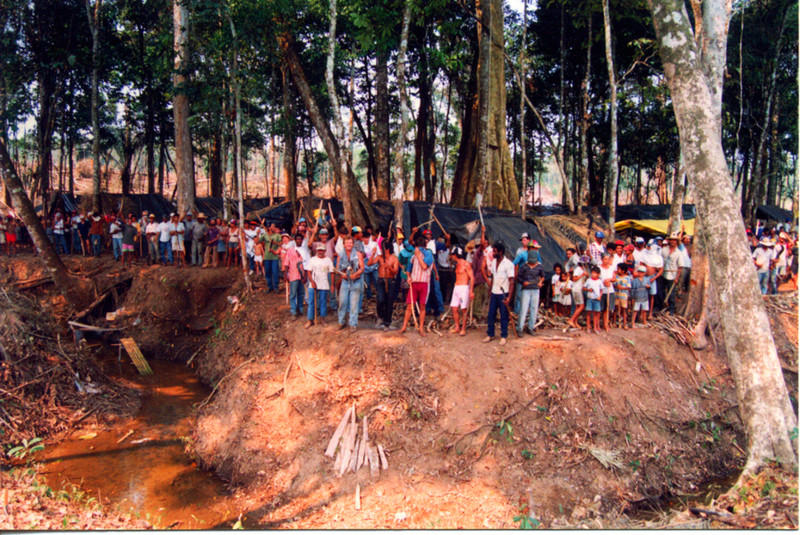
The State of Rondonia, located in the Western part of the Amazonian forest, had seen a growing migration of landless peasants since the 60s, with the promises of being given property titles to land they deforested. In reality, the latifundio who supposedly legally owned the property often used the peasants as free labor to work their land and once it was deforested, used their gunmen to kill or expel them.
In many cases, peasants resisted the latifundio, but the latafundio’s strength and the collaboration of the police, as well as the corruption of the local politicians, meant that those spontaneous rebellions were repressed with unpublicized massacres and genocide. The local chapter of MST in Rondonia saw the contradictions between its two factions intensify: while the revolutionaries called for broad mobilizations and a higher level of organization and combativity, the opportunists refused to act, under the pretext that the governor of the state, Valdir Raupp, was an ally of the PT. They claimed that acting against him could damage this alliance and prevent the PT from winning the next elections that would anyway “solve everything,” as the PT promised land reform after reaching power.
In July 1995, some 600 families mobilized by the dissident leadership of the MST seized 18,000 hectares (180 km2) of land in Santa Elina latifundio in the municipality of Corumbiara. The seized land was distributed equally among the families, and they began to construct houses. The “support” that the opportunists in the MST gave the struggle was to plead with the government to intervene in order to propose a “political solution” that would satisfy both the peasants and the latifundio. Indeed, at the end of July a delegation of different governmental institutions went to propose relocating the 600 families to a different 500 hectares (5 km2)—an unacceptable proposition given that at least 0.5 ha of land is required to grow food (under optimal conditions) to sustain one person per year. This proposed “solution” was actually a stab in the back to the masses. At the same time, the MST leadership gave the names of the leaders that headed the occupation of Santa Elina latifundio to the State.
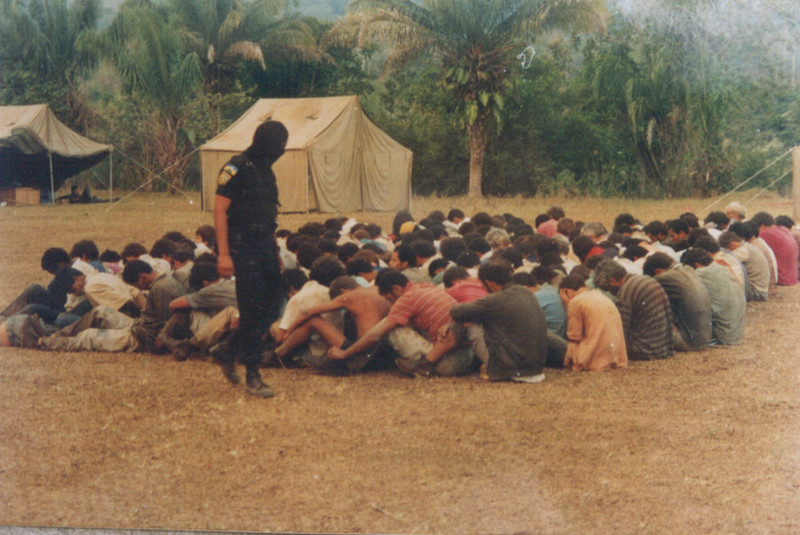
The refusal of this poisoned carrot brought the stick of repression. Less than a week afterwards, on August 9, the latifundists sent their gunmen with the support of police to evict the peasants. What is broadly known as the “Massacre of Corumbiara,” revolutionaries call the “Battle of Santa Elina.” The peasants were not passively massacred, because they were armed (including with a limited number of guns), and the lands were defended with these guns, machetes, sickles, traps and homemade bombs. They paid a price for their resistance: 16 were killed among whom, young Vanessa, 7 years old, was executed in cold blood by a policeman, 7 were disappeared, and over 200 were seriously injured by gunshots and stick and machete hits, with hundreds of men, women and elderly who were tortured during a whole day after surrendering.
The Battle of Santa Elina was the moment of rupture in which the revolutionaries realized the necessity of the split with the leadership of the MST, as they saw that the passivity, or in this context even the role of demoralization/demobilization of its leadership was an obstacle in forming an organization that would truly be able to struggle for agrarian reform. The organization that emerged six months after the bloody Battle of Santa Elina was founded on February 25, 1996, under the name Corumbiara Peasant Movement (MCC). Its first goal was to support the families of the combatants who fell in Santa Elina and the many who were wounded with bullets still in their bodies and to avenge them by re-seizing those lands.
Within the MCC, another line struggle appeared: while the majority supported the necessity of agrarian reform through revolutionary violence, a minority was slowly won to more “moderate” positions. Lula, the PT’s presidential candidate, was known by the peasants, because he appeared during the Santa Elina resistance to make promises to support them and their demands if he was elected. While the PT already proved by its “non-interference” in a massacre perpetrated with the complicity of their “political allies” that they were not on the side of the peasants, a minority still followed those false promises.
3. The League of Poor Peasants’ struggle in the time of Lula
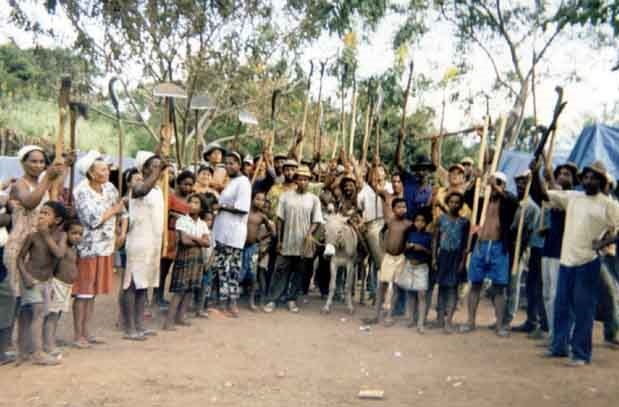 The limitations of the MCC as a regional organization were quickly identified as the Battle of Santa Elina inspired struggles in other Brazilian states. This was particularly the case in the North of Minas in the State of Minas Gerais, where families of peasants were organizing themselves and seizing lands under the leadership of the Worker’s and Peasant’s League. Together with the MCC, they formed a structure called Peasant Commissions of Struggle (CCL), which aimed to define a clear political line in order to form a nationwide organization.
The limitations of the MCC as a regional organization were quickly identified as the Battle of Santa Elina inspired struggles in other Brazilian states. This was particularly the case in the North of Minas in the State of Minas Gerais, where families of peasants were organizing themselves and seizing lands under the leadership of the Worker’s and Peasant’s League. Together with the MCC, they formed a structure called Peasant Commissions of Struggle (CCL), which aimed to define a clear political line in order to form a nationwide organization.
While at that time there were several organizations that already played the role of a nationwide peasant organization, the CCL saw them as being opportunistic and/or having a very limited perspective; their main concern was only to achieve “agrarian reform” within the boundaries of the old State, which was is in the hands of landlords and big bourgeois. However, the CCL believed that the peasant movement needed to struggle for agrarian revolution, meaning the total destruction of the latifundio, which would only be possible through a peasant-workers alliance that would not only transform the countryside, but the whole Brazilian society.
This was the line, synthesized by the document “Nosso Caminho” (“Our Path”), on which the League of Poor Peasants (LCP) was founded in April 2000. At its 1st Congress, it established five chapters of the League in different states and initiated contact in other states with groups of peasants that were occupying lands, as there was an uprising of spontaneous land occupation/seizure all over Brazil during that time.
The question of the land in Brazil became more and more of a “hot topic” in those years, both because the country was facing an economic crisis (as it was deeply impacted by the 1997 Asian financial crisis), but also because of the increase of agribusinesses in the country (from 18,000 in 1994 to 47,000 in 2001). Those companies were rapidly buying land from the latifundio which in many cases were occupied by poor peasants who were then evicted. Those two factors increased the poverty of the people and fueled their anger.
As the people’s anger and spontaneous land occupations increased it started to threaten the imperialists’ interests and present the possibility of a revolution. The situation was also not favorable to a military coup which could have brought the country to a state of civil war. The government of the Brazilian Democratic Movement Party, which had ruled the country since the end of the military regime, was unable to solve this political crisis.
While the PT had been running in the elections on the promise of a “land reform” and “transition to socialist economy,” its leader Lula (Luiz Inácio Lula da Silva, a former union leader who became popular because of his radical speeches when the military regime was falling at the end of 70s) proved to foreign investors that he wouldn’t endanger their interests by signing a public letter in 2002. The letter stated that he wouldn’t change Brazil’s economy policy, nor cancel any of its (unequal) international treaties.
Unsurprisingly, Lula won those elections with the unfortunate support of all “communist” parties of the country that daydreamed about the possibility of “radicalizing from within” the PT and its future government.
Once elected Lula launched a program called the “National Program for Agrarian Reform II,” purported to grant land titles to half a million poor peasants. This program was never implemented and became less and less of a priority, with the rationale that it would be done “when the time was right.” In the meantime, Lula said that the country was “big enough” for both agribusiness and poor peasants, and that they should make peace with each other(!). And to opportunists such as the leadership of the MST, who engaged in non-violent demonstrations appealing to the president to honor his promises, the PT leadership’s answer was: “Be patient.”
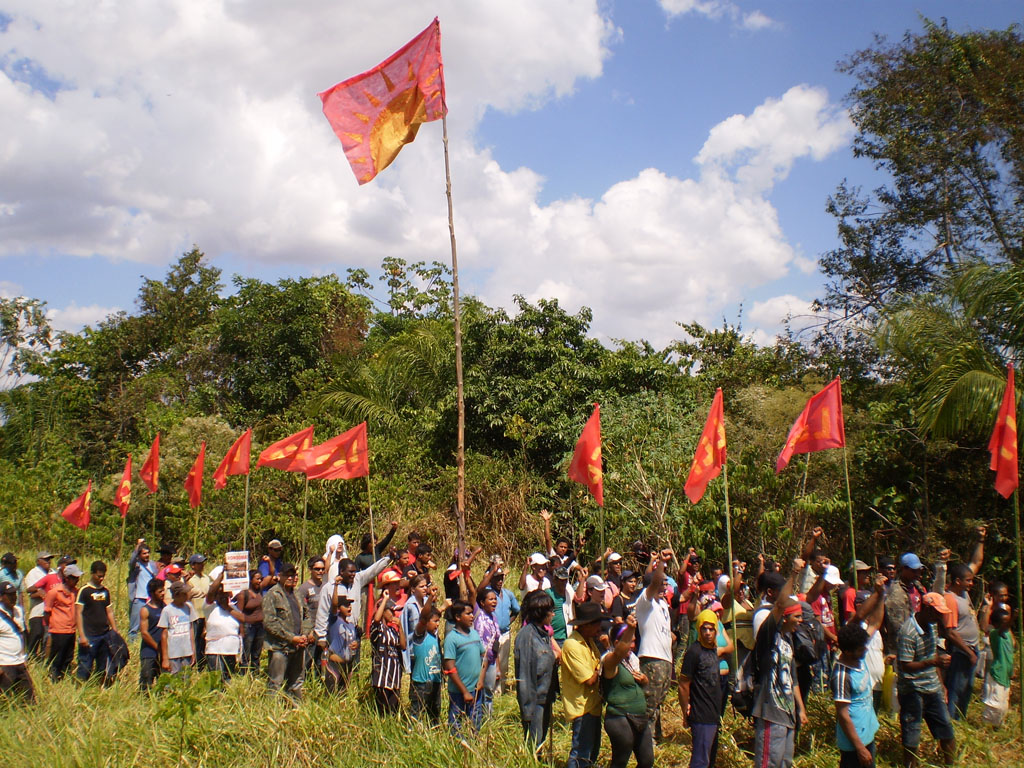 The LCP and poor peasants all over Brazil continued to seize and occupy lands, and they paid a price for their struggle. In the first year of Lula’s presidency, 73 peasants were murdered, double the number of the previous government. (There were 292 murders between 1995-2002, an average of 36 per year.)
The LCP and poor peasants all over Brazil continued to seize and occupy lands, and they paid a price for their struggle. In the first year of Lula’s presidency, 73 peasants were murdered, double the number of the previous government. (There were 292 murders between 1995-2002, an average of 36 per year.)
Besides the intensification of the killing of peasant leaders, the State initiated a psychological war to break the unity of the poor peasants. For example, in 2003 Lula issued a presidential decree that defined legal criteria of “quilombos.” Other legal definitions followed, dictating who legally qualified as a “landless peasant,” who was “indigenous,” etc. These different identities granted specific groups of people legal rights to claim some lands, and local authorities used them to create conflicts between the different communities (for example, by saying to quilombos that adjacent poor peasant villages were settled on lands that they could claim).
The peasants were told that they didn’t need to struggle, that it was enough to simply register (leading to the absurd situation where Brazil has more lands registered than its total landmass, as the latifundio do not “unregister” the lands that poor peasants register as theirs). These actions gave hope to some that this was the beginning of a more equal division of land, but the reality is that the latifundio have only seen an increase of their landholdings, as the government has allowed them to use legally public lands through the “Terra Legal” program, on the premise that it would help the Brazilian economy to grow. In reality, the program advanced destructive forms of land exploitation, such as a rapid deforestation of Amazonia, and the devastating practice of cash-crop eucalyptus cultivation, sugarcane, cattle and mining.
4. Intensification of the Peasants Movement since 2013
Lula served two terms and was replaced in 2011 by another PT figure, Dilma Rousseff. She played the role of successor, continuing the same politics of support to agribusiness and monoculture for export (i.e., plundering of the country resources for imperialist profit) that Lula initiated.
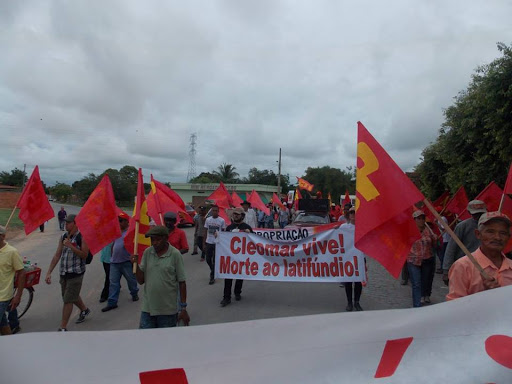 During her term the peasant movement intensified, particularly after the watershed 2013 protests that gripped the country. Several leaders of the LCP were murdered; in 2012, Renato Nathan was murdered in the State of Rondonia and in 2014 Cleomar Rodrigues, leader in the region of Norte de Minas, was assassinated at the gates of a revolutionary area that he helped organize and where he had been living and working since 2008.
During her term the peasant movement intensified, particularly after the watershed 2013 protests that gripped the country. Several leaders of the LCP were murdered; in 2012, Renato Nathan was murdered in the State of Rondonia and in 2014 Cleomar Rodrigues, leader in the region of Norte de Minas, was assassinated at the gates of a revolutionary area that he helped organize and where he had been living and working since 2008.
The impeachment of Rousseff in 2016, a consequence of her involvement in corruption scandals, created a situation in the country where the dominant classes became divided. With the economic crisis (that was both national and international) threatening their interests, they saw that the masses lost their confidence in the PT, because it proved unable to solve the most basic issues of the people, such as carrying out land reform.
Indeed, the thirteen years of the opportunist governments of PT were years of betrayal of the peasants and other workers. No “agrarian reform” was promoted. On the contrary, the repression to the revolutionary peasant movement was greater than the previous governments. As for the leaders of the MST, they simply reached the bourgeois-landlord state’s bureaucracy. With this, the leadership of the MST gradually abandoned the struggle against latifundio, centering in the defense of “agroecology” and the denunciation of the foreign giants that produce agrotoxins and transgenic seeds, tractors and machinery, under the banner of a supposed “people’s agrarian reform.” The MST leadership not only abandoned the tactics of “occupation” but started to attack the revolutionary peasant movement, they colluded and were complicit in murdering the leaders and masses. They were part of the “task force” of political police and repressive forces and other organs of the old state, despite opportunist mass organizations promoting the “Operation Peace in the Countryside,” which was responsible for persecutions, arrests and elimination of social fighters.
And this growing lack of confidence in both the PT, and its number one promoter, the MST leadership, led to an increased abstention (not showing up, null or blank votes), in spite of voting being mandatory in Brazil. In the last elections in 2018, many people turned towards the far-right to express their anger at the situation, including against the policies and consequences of opportunism. Those two factors resulted in the election of the fascist Bolsonaro by only 30% of the people eligible to vote: Bolsonaro had 57 million votes, Haddad (PT) 46 million, and the boycott had 57 million people, in what was the most boycotted election in the history of Brazil.
Since 1995, the revolutionary peasant movement has called for the election’s boycott and since its founding, the LCP has called to boycott the elections. Today the opportunists are saying that Brazil is now a fascist state, and that the only political intervention possible is to call to free Lula (who was imprisoned from 2017 until mid-2019, convicted of corruption and money laundering). But the League continues to advance their line of destroying latifundio, seizing land by land, step-by-step, and declares that it is not possible to further advance the struggle for land anymore without re-editing the sacred and historical peasant war through a correct and justified revolutionary strategy and political line. For this they defend and declare the necessity of increasing the number of militant mobilizations to resist the evictions and continue to seize even more land.
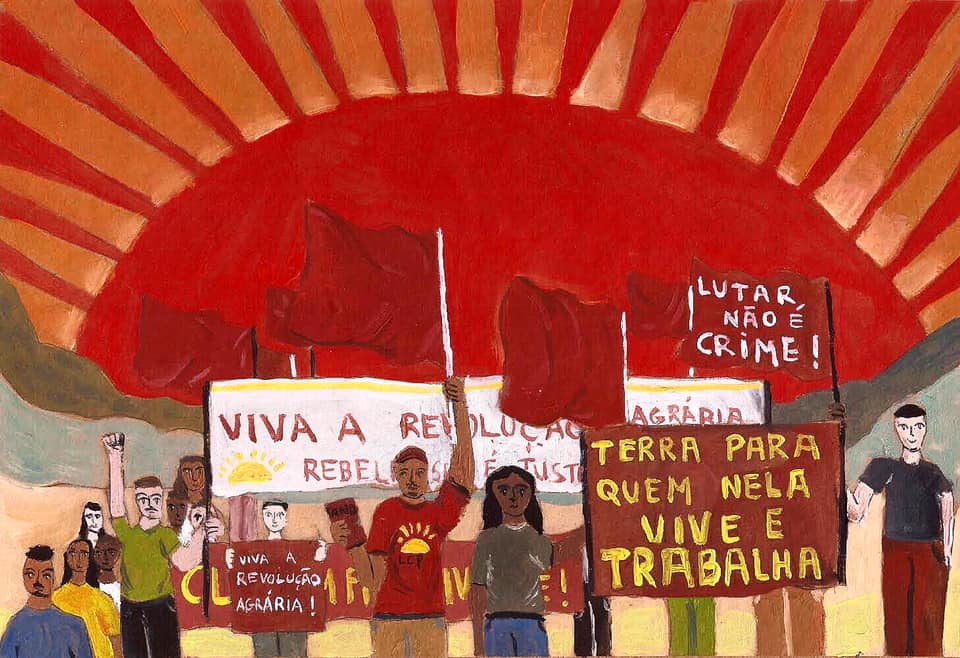
References
Revolutionary sources
- LCP, Nosso Caminho, 2001, revised in 2018
- Problemas da historia do Partido Comunista do Brasil, 2016
- Articles from Resistencia Camponesa (LCP newspaper) and A Nova Democracia
Other sources
- Goza, Franklin. Brazilian Frontier Settlement: The Case of Rondônia, 1994
- A Liga dos Camponeses Pobres (LCP) e a luta pela terra no Nordeste, David Pimentel Oliveira Silva, 2014
- Revisiting Agrarian Reform in Brazil, 1985–2016, Wilder Robles, 2018
Art credit
- Brazilian artist Antonio Kuschnir

